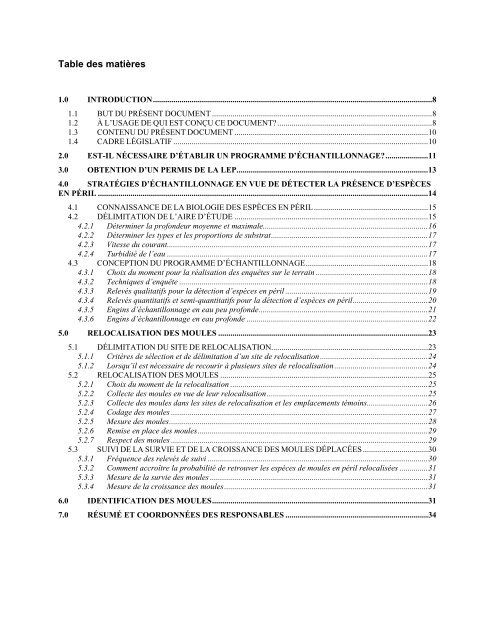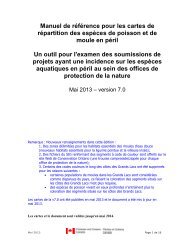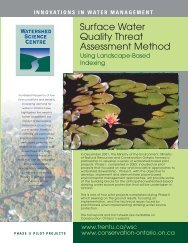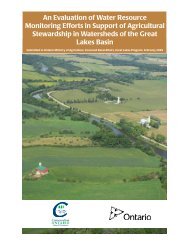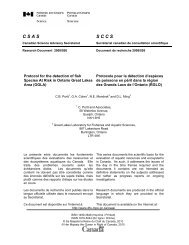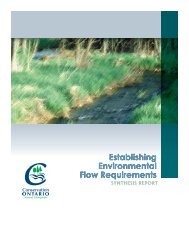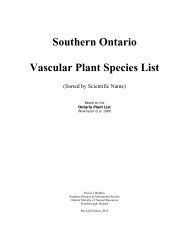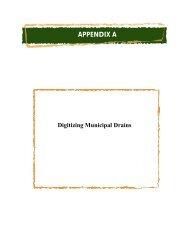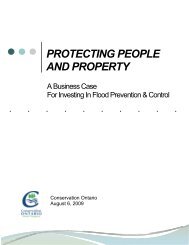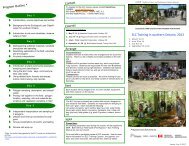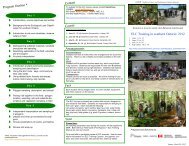Protocole pour la détection et détournement des espèces de moules
Protocole pour la détection et détournement des espèces de moules
Protocole pour la détection et détournement des espèces de moules
- No tags were found...
You also want an ePaper? Increase the reach of your titles
YUMPU automatically turns print PDFs into web optimized ePapers that Google loves.
Table <strong><strong>de</strong>s</strong> matières1.0 INTRODUCTION.........................................................................................................................................81.1 BUT DU PRÉSENT DOCUMENT ............................................................................................................81.2 À L’USAGE DE QUI EST CONÇU CE DOCUMENT?............................................................................81.3 CONTENU DU PRÉSENT DOCUMENT ...............................................................................................101.4 CADRE LÉGISLATIF .............................................................................................................................102.0 EST-IL NÉCESSAIRE D’ÉTABLIR UN PROGRAMME D’ÉCHANTILLONNAGE?.....................113.0 OBTENTION D’UN PERMIS DE LA LEP..............................................................................................134.0 STRATÉGIES D’ÉCHANTILLONNAGE EN VUE DE DÉTECTER LA PRÉSENCE D’ESPÈCESEN PÉRIL ..................................................................................................................................................................144.1 CONNAISSANCE DE LA BIOLOGIE DES ESPÈCES EN PÉRIL........................................................154.2 DÉLIMITATION DE L’AIRE D’ÉTUDE ...............................................................................................154.2.1 Déterminer <strong>la</strong> profon<strong>de</strong>ur moyenne <strong>et</strong> maximale.................................................................................164.2.2 Déterminer les types <strong>et</strong> les proportions <strong>de</strong> substrat.............................................................................174.2.3 Vitesse du courant................................................................................................................................174.2.4 Turbidité <strong>de</strong> l’eau ................................................................................................................................174.3 CONCEPTION DU PROGRAMME D’ÉCHANTILLONNAGE............................................................184.3.1 Choix du moment <strong>pour</strong> <strong>la</strong> réalisation <strong><strong>de</strong>s</strong> enquêtes sur le terrain .......................................................184.3.2 Techniques d’enquête ..........................................................................................................................184.3.3 Relevés qualitatifs <strong>pour</strong> <strong>la</strong> <strong>détection</strong> d’<strong>espèces</strong> en péril ......................................................................194.3.4 Relevés quantitatifs <strong>et</strong> semi-quantitatifs <strong>pour</strong> <strong>la</strong> <strong>détection</strong> d’<strong>espèces</strong> en péril.....................................204.3.5 Engins d’échantillonnage en eau peu profon<strong>de</strong>...................................................................................214.3.6 Engins d’échantillonnage en eau profon<strong>de</strong> .........................................................................................225.0 RELOCALISATION DES MOULES .......................................................................................................235.1 DÉLIMITATION DU SITE DE RELOCALISATION.............................................................................235.1.1 Critères <strong>de</strong> sélection <strong>et</strong> <strong>de</strong> délimitation d’un site <strong>de</strong> relocalisation.....................................................245.1.2 Lorsqu’il est nécessaire <strong>de</strong> recourir à plusieurs sites <strong>de</strong> relocalisation..............................................245.2 RELOCALISATION DES MOULES ......................................................................................................255.2.1 Choix du moment <strong>de</strong> <strong>la</strong> relocalisation .................................................................................................255.2.2 Collecte <strong><strong>de</strong>s</strong> <strong>moules</strong> en vue <strong>de</strong> leur relocalisation...............................................................................255.2.3 Collecte <strong><strong>de</strong>s</strong> <strong>moules</strong> dans les sites <strong>de</strong> relocalisation <strong>et</strong> les emp<strong>la</strong>cements témoins..............................265.2.4 Codage <strong><strong>de</strong>s</strong> <strong>moules</strong> ..............................................................................................................................275.2.5 Mesure <strong><strong>de</strong>s</strong> <strong>moules</strong>...............................................................................................................................285.2.6 Remise en p<strong>la</strong>ce <strong><strong>de</strong>s</strong> <strong>moules</strong>.................................................................................................................295.2.7 Respect <strong><strong>de</strong>s</strong> <strong>moules</strong> ..............................................................................................................................295.3 SUIVI DE LA SURVIE ET DE LA CROISSANCE DES MOULES DÉPLACÉES ................................305.3.1 Fréquence <strong><strong>de</strong>s</strong> relevés <strong>de</strong> suivi ............................................................................................................305.3.2 Comment accroître <strong>la</strong> probabilité <strong>de</strong> r<strong>et</strong>rouver les <strong>espèces</strong> <strong>de</strong> <strong>moules</strong> en péril relocalisées ..............315.3.3 Mesure <strong>de</strong> <strong>la</strong> survie <strong><strong>de</strong>s</strong> <strong>moules</strong> ...........................................................................................................315.3.4 Mesure <strong>de</strong> <strong>la</strong> croissance <strong><strong>de</strong>s</strong> <strong>moules</strong>....................................................................................................316.0 IDENTIFICATION DES MOULES..........................................................................................................317.0 RÉSUMÉ ET COORDONNÉES DES RESPONSABLES ......................................................................34


